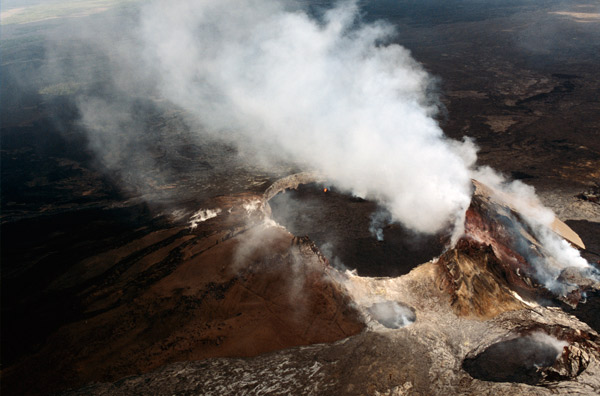Using AI to control energy for indoor agriculture
30 September 2024
Published online 25 October 2017
Changes in summer flooding of the Nile are driven by volcanoes as far away as Iceland.

© Getty Images
In addition to shedding light on Egyptian history, the findings highlight the value of socio-ecological framework in understanding history.
The analysis started with data from the Islamic Nilometer, an annual hydrological meter tracking Nile flood levels as far back as 622 CE. The team correlated Nilometer records from 622 until 1902, when the Aswan Low Dam was completed, with evidence from ice cores showing when volcanic eruptions had occurred.
“It’s only since 2015 that the ice core data has been precise enough to give us dates for these events with an error of about one year instead of plus-or-minus ten years by the time we get back to the Ancient period,” says Francis Ludlow, a historical climatologist at Trinity College Dublin who was one of the lead authors of the study.
With the more precise data, the team discovered a link between volcanic eruptions and the extent of Nile flooding.
Explosive eruptions launch sulphurous gases into the atmosphere which become aerosols and reflect away sunlight, decreasing average global rainfall and temperatures. The cooling effect of eruptions that occur at high latitudes, such as in Iceland, is concentrated in the northern hemisphere. This imbalance causes a shift in monsoons, which fail to migrate as far northwards as normal.
Regions such as Ethiopia see a major drop in rainfall normally brought by the monsoon winds, leading to a drop in the level of the Nile’s summer flood, supplied mainly from the Blue Nile arising in the Ethiopian Highlands.
“We moderns tend to think we are exempted from natural changes, or man-made ones. But we are not."
According to the analysis, an average drop of 22 cm occurred in eruption years, with the drop increasing as the analysis was restricted to larger and larger eruptions. The reduction would have been devastating for farmers, who weren’t able to carry or pump enough water for irrigation and so relied on Nile flooding to water their crops.
“Depending on how flat your land on either side of the Nile was, it could mean the difference between having a crop or having no crop,” says Ludlow.
Next, the team turned to Ptolemaic Egypt, a period with less thorough records of Nile flooding levels but rich in other historical documents.
By combining information from these documents with ice core data about volcanic eruptions, they showed that periods of social unrest coincided with eruption years.
Tax records and land ownership records revealed that uprisings against the rule of the Ptolemies were more common during and shortly after eruptions, when the researchers predict flooding levels would have been lower.
Ludlow emphasizes the value of tracking the ownership of land, which ancient Egyptians kept within a family for generations. The sale of land outside of families significantly increased after eruptions, which Ludlow calls “a real reflection of the stress in society.”
Volcanic disruptions of the Nile’s activity were also linked with how the Ptolemies dealt with their neighbours. Around 245 BCE, Ptolemy III abruptly abandoned a successful military campaign against the kingdom’s rival, the Seleucid Empire. This about-face “changed everything about Near-Eastern history,” says Joseph Manning, a Yale University historian who co-led the study.
Manning and Ludlow’s findings lend credence to the theory that Ptolemy abandoned the war because he had to deal with disturbances in Egypt.
The team believe that major eruptions in 247 and 244 BCE led to a failure of Nile flooding which incited domestic unrest.
Their analysis showed that volcanic eruptions throughout the Ptolemaic period correlated with the end of military campaigns but not their start, suggesting that unrest linked with the eruptions may have limited the Ptolemies’ ability to continue prosecuting expensive wars abroad.
However, while the study shows a clear influence of volcano-related climatic disruptions on the course of Ptolemaic Egypt’s history, the researchers stress that many other factors were also at play, with Nile flooding interacting with and amplifying other stressors.
The findings also have implications for contemporary societies. For example, the Grand Ethiopian Renaissance Dam, which is expected to dramatically alter hydro-politics in the region, will be affected. However, the researchers raise the concern of a possible impact of volcanic eruptions on water availability, which could add stress to an already sensitive situation.
“We moderns tend to think we are exempted from natural changes, or man-made ones. But we are not," says Manning.
Next, the team plans to turn their attention to other ancient civilizations, such as Chinese dynasties and Babylon, where excellent records of the level of the Euphrates were kept for centuries.
In addition to revealing how climatic factors affected the history of these societies, the analysis also serves as “a tool to investigate the relative vulnerability of different social and agricultural systems globally,” says Ludlow.
“I’m hoping to see which societies were more vulnerable and which were more resilient and then follow up by examining the context of these differences. Was their agriculture different? Was their political setup different?”
According to Manning, there’s still “a long way to go in understanding how to deeply integrate climate change into historical analysis.”
doi:10.1038/nmiddleeast.2017.151
Stay connected: